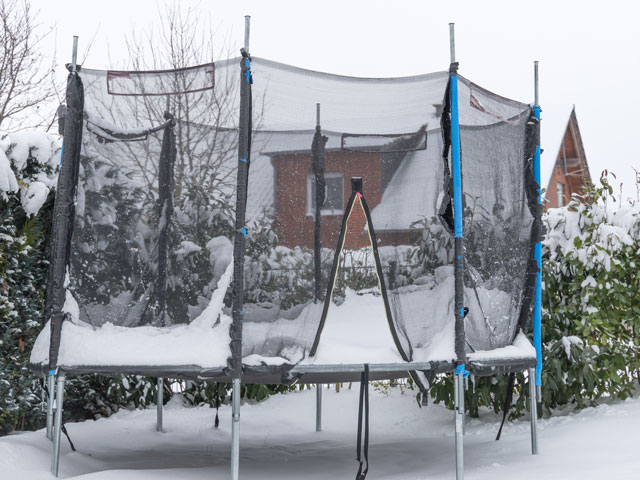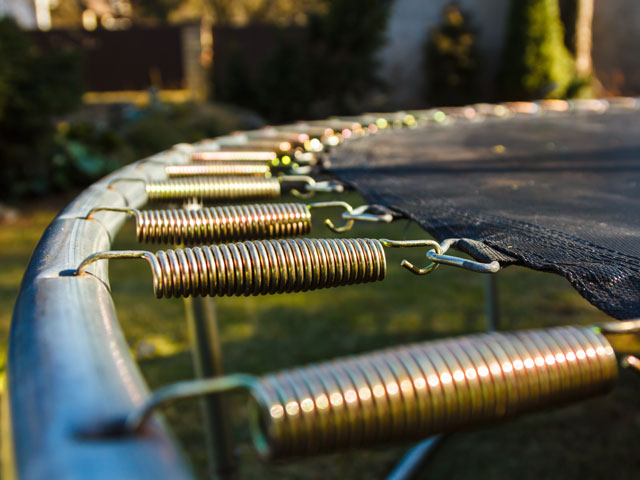How to Use and Protect Your Trampoline in Winter
It seems counterintuitive to jump on a trampoline in the winter, but we assure you it's possible.

Playing outdoors is not only good for the fresh air, it's also refreshing to see your kids put down the Nintendo and get some exercise. And what better way to get some in the winter than jumping for an hour on the backyard trampoline, as jumping can burn calories at a really high rate.
So we set some expectation with you, we aren't really concerning ourselves with the ability to use a trampoline in Winter in the South. Nor are discussing Southern Cali, Arizona and the surrounding areas where temperatures don't (really) approaching freezing between Thanksgiving and St. Patrick's Day.
We're really answer this question for the Northern States and Canadian Provinces where snowfall is moderate to significant and the wind really gusts. Heavy winds and freezing moisture are not good for both a fun Wintertime bounce, as well as the proper upkeep and maintenance of your trampoline. Yes, the cold temps are less ideal than a casual 72 degree day, but the wind and rain/snow will do more damage than the cold.
Properly Winterizing Your Trampoline
The best way to properly winterize your trampoline is to put it away for the winter. Yes, we understand that that means that you cannot jump on it over Holiday Break. To be fair, we didn't say winterizing it would be all types of fun, we just said that that's the best method for ensuring it's safety and protection throughout the winter months.
If you take that route, you will need to learn how to properly take your trampoline down.
Step 1: Clean Your Trampoline
Start the winterization process by removing all of the dust, debris, detritis or otherwise that has built up throughout the Spring, Summer and Fall.
You can take a few different routes to accomplish this. You can either:
- Use a Brush
- Use your Leaf Blower
If you opt for a brush, know that almost any soft to medium bristle brush will do. This includes the brush from the dust pan in your kitchen cabinet as well as the one you use to remove snow from your car.
If you opt for the Left Blower like Tim "The Toolman" Taylor approach from the 90s show, Home Improvement, know that you will want ear plugs and goggles to go along with it.
Other things that can build up over the year include fabrics from clothing, given that articles of clothing can get caught and rip during usage. Always exhibit good judgment when dressing for trampoline use.
That also goes for observing posted weight limits.
Step 2: Remove the Enclosure
It's kind of hard to take down any trampoline when you still have the enclosure set up. Doubly so if a basketball hoop is involved. So, make sure you take down any netting, tenting or otherwise prior to collapsing your unit.
Pro-Tip: Give the netting/tenting a good cleaning before you store it for the season.

Step 3: Remove the Padding
Remove the pads that protect the springs. Take some time to disinfect them as well. Remember, this is equipment that has been sitting outside for the better part of a year and it's headed straight back into your home. You're going to want to make sure it gets cleaned first.
Step 4: Remove the Ground Anchors
As part of the collapsing process, you're going to want to remove the anchors in the ground. Like everything else, make sure they are cleaned up prior to putting them back in the storage bag. If you are using sandbags as anchors, make it a point to store them in a dry place indoors - either in your rec room or on shelving in the basement and/or garage. The latter is less of a problem in dry climates and for houses that don't get damp in the basement.
Step 5: Take Down the Equipment
Take down the jumping mat, the rings, the springs, and all of the things. Ok, we liked that just because it rhymed.
To avoid rust and corrosion, properly clean and dry all of the parts. This is especially true if you're trampoline contains any electrical connections, battery packs, cable connectors or otherwise. Now that you've completed these steps, it's time for you to find a convenient and safe place for storage indoors.
That said, if you're looking for wintertime enjoyment, switch to a bounce house, as it's possible to set up a bounce house indoors.
Bonus Step: Inspect for Repairs / Wear & Tear
It's a good idea to inspect your trampoline, or any bounce houses, inflatables or otherwise, for wear and tear at the end of the season. You're far more likely to be able to perform adequate repairs at this time than early next season when you've forgotten what the problem is.
Leaving a Trampoline Outside in the Winter Season
Yes, you can leave your trampoline outdoors in the winter. We had a bunch of questions we wanted answered before the first time we tried doing just that, and so now we're here to answer them for you.

How do I remove snow from a Trampoline?
Much like your vehicle, you will want to use a soft-bristle brush to clean snow off of your trampoline's frame and jumping mat. Using a shovel, especially a metal one, is highly discouraged as it can cause significant damage to the important parts of the trampoline.
These instructions also apply to the late Fall and early Spring, as dirt, leaves, sticks and other highly wind strewn articles of nature can build up on the surface of your outdoor trampoline as well as in the hard to reach areas, making cleaning a bit more of a chore.
You can also always use a long brush like the kind you use for your roof (seen above). But be gentle, as you don't want to tear up the jumping mat.
Will my Trampoline get damaged?
It is possible for a trampoline to sustain damage in winter if it is not properly covered. Plus, you will want to make sure that you consistently remove snow from the jumping surface.
Is there anything that will protect my Trampoline from the snow and wind?
Yes, weather covers will help to protect your trampoline in adverse weather conditions. Weather covers come in a variety of sizes and are made with durable materials to withstand moderate to heavy winds and winter snowfall. Weather covers also help to protect the jumping mat from sustained UV damage from the sun. Furthermore, a weather cover will help protect your trampoline from rain as well.